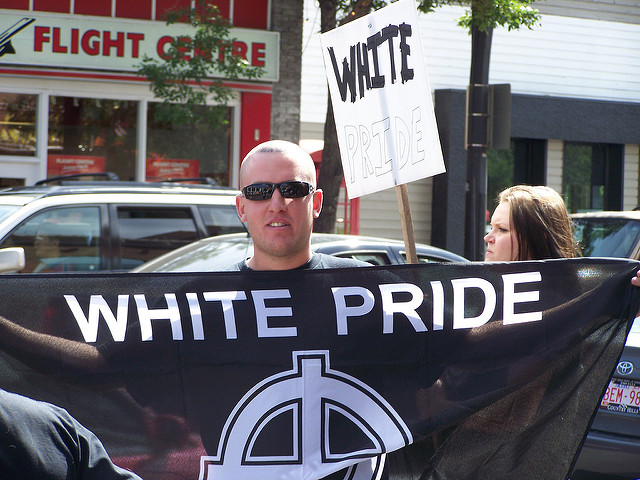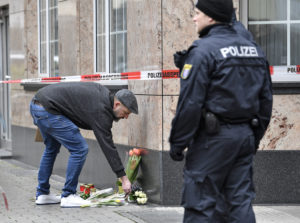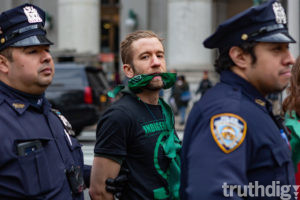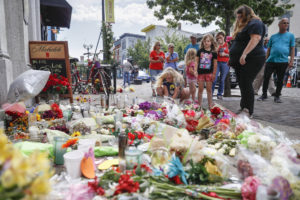Far Right Increasingly Responsible for Mass Violence: Report
Donald Trump blames immigrants but he might look to his own backyard. Robert Thivierge / Flickr Creative Commons
Robert Thivierge / Flickr Creative Commons
On the Sunday of Thanksgiving weekend, U.S. Border Patrol fired tear gas on Central American migrants at the Mexican border. Many of the victims were children, brought with their parents who are fleeing violence in their home countries. The Trump administration views, or at least claims to view, these families as a threat to American safety. However, as a new report from The Washington Post shows, perhaps they should be looking closer to home.
“Over the past decade,” the Post writes, “attackers motivated by right-wing political ideologies have committed dozens of shootings, bombings and other acts of violence, far more than any other category of domestic extremist.”
The trend has only gotten worse. As the Post observes, “while the data show a decades-long drop-off in violence by left-wing groups, violence by white supremacists and other far-right attackers has been on the rise since Barack Obama’s presidency—and has surged since President Trump took office.”
Anti-Semitic attacks in particular have increased, with a 17 percent rise in such hate crimes in 2017, as the FBI found in Hate Crime Statistics 2017, a report released this month.
“We are definitely at an inflection point,” Brian Levin, director of the Center for the Study of Hate and Extremism at California State University, San Bernardino, told The Wall Street Journal after the FBI report was released. He continued, “We have now risen to the highest level in about a decade. That is a cause for concern.”
The Post’s analysis corroborates and expands on two earlier reports analyzing data from the Global Terrorism Database: one from the National Consortium for the Study of Terrorism and Responses to Terrorism (START) at the University of Maryland, which covered from 1970 to 2016, and a 2017 follow-up from Quartz, which also used data from the Global Terrorism Database. The START report observed:
In comparison to the 2000s, there was a sharp decline in the proportion of terrorist attacks carried out by left-wing, environmentalist extremists during the first seven years of the 2010s (from 64% to 12%). At the same time, there was a sharp increase in the proportion of attacks carried out by right-wing extremists (from 6% to 35%) and religious extremists (from 9% to 53%) in the United States.
Quartz found that in 2017 the trend continued: “Out of 65 incidents last year, 37 were tied to racist, anti-Muslim, homophobic, anti-Semitic, fascist, anti-government or xenophobic motivations.”
2018 may be the deadliest year so far. A recent spate of incidents included a shooting in a Kroger supermarket in Kentucky, another in a Pittsburgh synagogue, another in a Florida yoga studio, one in a California bar. “All told,” the Post reports, “researchers say at least 20 people have died this year in suspected right-wing attacks.”
In addition to blaming immigrants for violence, Trump and his supporters frequently claim that left-wing groups are responsible for shootings and other large-scale violence. According to the Post’s research, only one incident meets that criterion, when Tierre Guthrie, an ex-Marine whom the Post describes as sympathetic to black nationalist groups, killed a police officer when being arrested at his home after missing a hearing for a traffic violation. Right-wing, Trump-sympathetic outlets like the Washington Examiner and even mainstream sites like Newsweek questioned whether the shooter’s support for Bernie Sanders and ire against Trump were among the motives for the shooting.
Experts. however, “say right-wing extremists perceive the president as offering them tacit support for their cause.” When, days before the midterm elections, Trump via video accused the Democrats of flooding America with thousands of undocumented immigrants, members of one far-right message board rejoiced. One poster was especially inspired, writing, “I love it. We should be making videos like this.” As The New York Times reported this month, “these far-right communities have entered into a sort of imagined dialogue with the president. They create and disseminate slogans and graphics, and celebrate when they show up in Mr. Trump’s Twitter feed days or weeks later.”
These slogans and graphics have impacts far beyond the corners of the internet where they’re created. “If you have politicians saying things like our nation is under attack, that there are these marauding bands of immigrants coming into the country, that plays into this right-wing narrative. They begin to think it’s OK to use violence,” Gary LaFree, criminology chairman at the University of Maryland and founding director of the National Consortium for the Study of Terrorism and Responses to Terrorism, told the Post.
Frank Figliuzzi, a former FBI assistant director for counterintelligence, was even more blunt: “The current political rhetoric is at least enabling, and certainly not discouraging, violence.”
The Trump administration also doesn’t see programs aimed at countering this kind of extremism as a funding priority. It had previously put a hold on Countering Violent Extremism, a $10 million grant program, under the auspices of the Department of Homeland Security, aimed at fighting domestic terrorism. A few grants were finally distributed months later. As NBC News reported in October, “At least four grants were canceled, however, and three recipients confirmed that they had declined the grants, all citing political disagreements with the Trump administration.”
Now, NBC continues, the DHS has no plans to continue funding the program past July 2019.
Your support is crucial...
As we navigate an uncertain 2025, with a new administration questioning press freedoms, the risks are clear: our ability to report freely is under threat.
Your tax-deductible donation enables us to dig deeper, delivering fearless investigative reporting and analysis that exposes the reality beneath the headlines — without compromise.
Now is the time to take action. Stand with our courageous journalists. Donate today to protect a free press, uphold democracy and uncover the stories that need to be told.







You need to be a supporter to comment.
There are currently no responses to this article.
Be the first to respond.